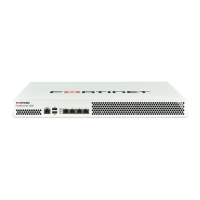NVR configuration Page 22 FortiRecorder 2.4.2 Administration Guide
6. To verify connectivity, from a computer on the route’s network destination, attempt to ping
one of FortiRecorder’s network interfaces that should be reachable from that location.
If the connectivity test fails, you can use the CLI commands:
execute ping <destination_ipv4>
to determine if a complete route exists from the FortiRecorder to the host, and
execute traceroute <destination_ipv4>
to determine the point of connectivity failure.
Also enable PING on the FortiRecorder’s network interface, then use the equivalent
tracert or traceroute command on the computer (depending on its operating system)
to test routability for traffic traveling in the opposite direction: from the host to the
FortiRecorder.
• If these tests fail, or if you do not want to enable PING, first examine the static route
configuration on both the host and FortiRecorder.
To display the cached routing table, enter the CLI command:
diagnose netlink rtcache list
You may also need to verify that the physical cabling is reliable and not loose or broken,
that there are no IP address or MAC address conflicts or blacklisting, and otherwise rule
out problems at the physical, network, and transport layer.
• If these tests succeed, a route exists, but you cannot connect using HTTP or HTTPS, an
application-layer problem is preventing connectivity.
Verify that you have enabled HTTPS and/or HTTP on the network interface. Also examine
routers and firewalls between the host and the FortiRecorder appliance to verify that they
permit HTTP and/or HTTPS connectivity between them. Finally, you can also use the CLI
command:
diagnose system top 5 30
to verify that the daemons for the web UI and CLI, such as sshd, newcli, and httpd are
running and not overburdened.
To configure DNS settings
1. Log in to the admin administrator account.
Other accounts may not have permissions necessary to change this setting.
2. Go to System > Network > DNS and enter the IP addresses of a primary and secondary DNS
server. Your Internet service provider (ISP) may supply IP addresses of DNS servers, or you
may want to use the IP addresses of your own DNS servers.
3. Click Apply.
If you will use the settings DHCP and Retrieve default gateway and DNS from server when you
configure your network interfaces, skip this — DNS is configured automatically.
Incorrect DNS settings or unreliable DNS connectivity can cause issues with other features,
including the NTP system time. For improved performance, use DNS servers on your local
network.

